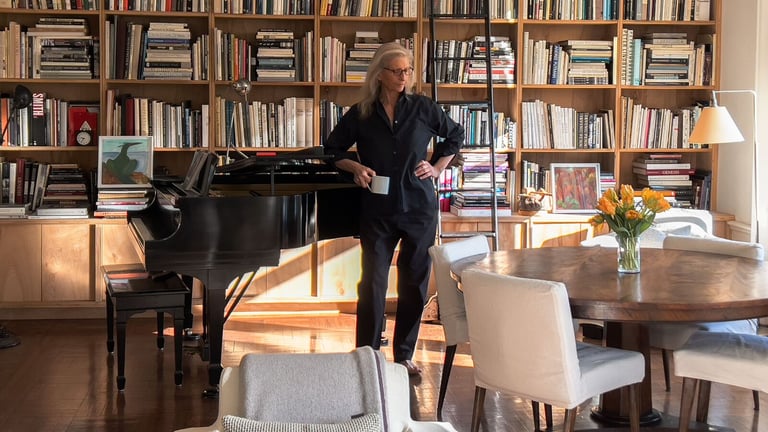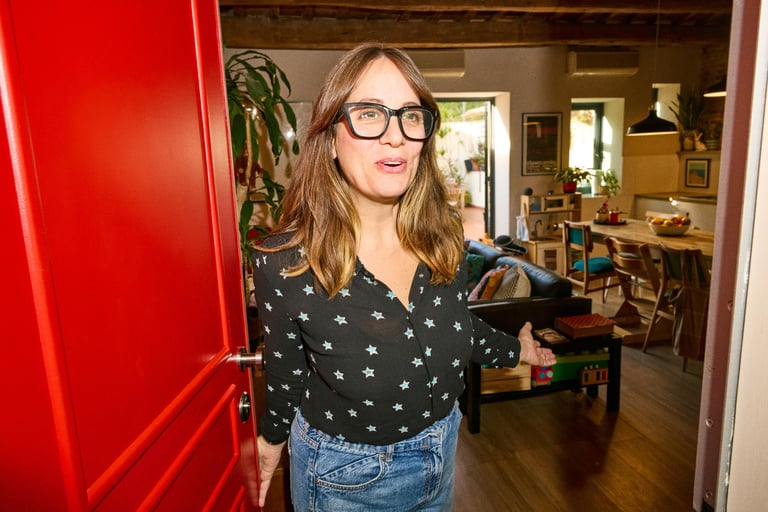
Life at Home Report 2024
Bring
joy home
Every year we speak to people around the world to find out what life at home means today, and how we can help make it better. That’s what the IKEA Life at Home Report is all about. This year, we’re exploring the opportunities for enjoyment at home – and unleashing the magic of joyful everyday moments.
Making room
for enjoyment
Eight needs for a better life at home
For the second year running, the Life at Home Report is based on the eight needs framework: a model of people’s emotional and functional needs that helps us understand what makes a better life at home.
Each of the needs has its own set of drivers and barriers. They’re factors that motivate us, or hinder us, when it comes to fulfilling that need at home.
Enjoyment is one of the eight needs. We define it as uplifting moments of appreciation or joy that give us warmth and happiness.
Our everyday essentials
Control
Having agency over our environment, what goes into it and how it is used.
Comfort
Making sure our environment allows us to feel content and at ease.
Security
Protecting what we care about so that we feel secure and resilient to the changes of the world around us.
Our regular connections
Nurturing
Connecting with ourselves and taking care of our mental and physical wellbeing.
Belonging
Feeling we are accepted for who we are by the people that we live amongst and in places that reflect us.
Our meaningful moments
Enjoyment
Having uplifting moments of appreciation or joy that give us warmth and happiness.
Accomplishment
Feeling a sense of pride and progress by achieving our goals and improving our abilities.
Our future plans
Aspirations
Feeling positive and prepared for our futures.
The enjoyment opportunity
This year, we learned that those who experience enjoyment regularly at home are more likely to feel satisfied with their lives and optimistic about the future.
However, a third of us just aren’t getting enough of it. More than 1 in 3 people find enjoyment important but only sometimes, rarely or never have it fulfilled at home.
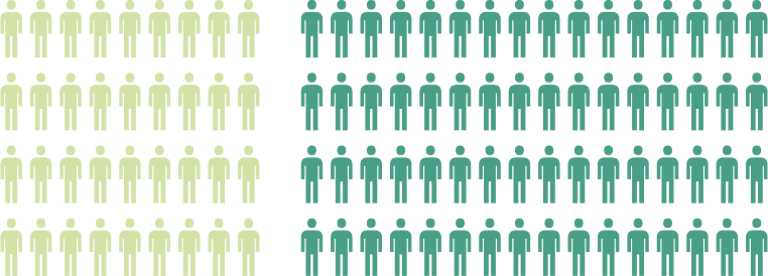
Those who find enjoyment important, but don’t often have it fulfilled at home (36%)
Everyone else* (64%)
*Those who find enjoyment important and often have it fulfilled at home, those who don’t find enjoyment important, and those who don’t know.
At IKEA, our mission is to improve everyday life for the many. We understand the role that home can play as a sanctuary from the pressures of daily life and unpredictable events in the world at large. And we believe in the magic of joyful everyday moments to help make that happen.
A recipe for joy
So how can we bring more joy into the home? Our research has uncovered four main topic areas connected to enjoyment at home – each with their own drivers and barriers.
1.
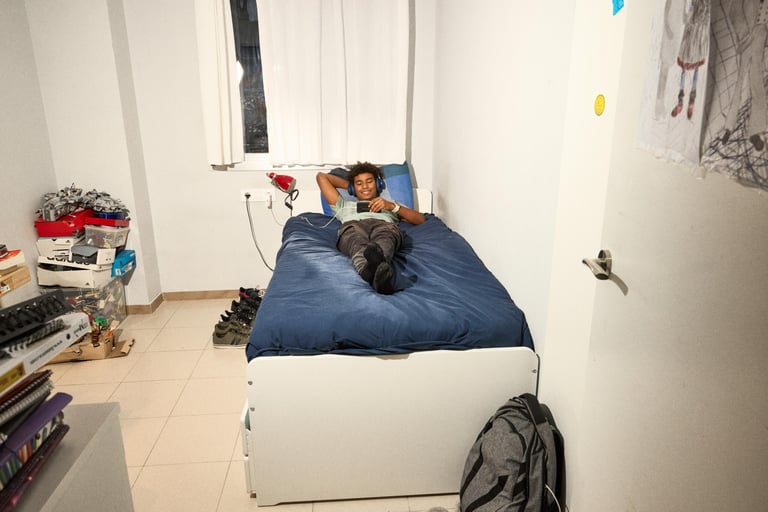

Feeling good
Redefining a healthy, happy home
A reimagined vision of home health shows that our living spaces can empower us, with possibilities to craft our own version of wellbeing and an environment that caters to our unique needs.
Whatever we choose to prioritise, it’s all about those small, meaningful changes we can make to help us feel authentically good.
Top driver
Home cooking boosts everyday joy.
Eating a home-cooked meal (28%) ranks #5 globally in bringing enjoyment at home.
Top barrier
Lower income raises health concerns.
The lower your income, the more likely you are to have mental and physical health concerns (+3% and +5% points respectively, vs higher income).
Relevant needs
Enjoyment
Control
Accomplishment
Nurturing
Security
“With the mental health crisis, how are we nurturing ourselves? We mask and distract ourselves and we’re overstimulated by tech. It’s about reclaiming our environment and our spaces.”
– Michelle Lam, Foresight Strategist
Main themes
1.1 Home, wellbeing and outlook go together
The relationship between increased wellbeing and enjoyment of our home is mutually reinforcing. In other words, a supportive home environment can promote our mental and physical wellbeing, as well as our outlook on life and the future – which can, in turn, feed back into the home.
Key insight
Don’t worry, be happy
Those who don’t feel concern about their mental and physical health are more likely to be happy in their life at home (64% vs 61% global average).
1.2 Home health is multidimensional
The idea of ‘home health’ captures the diverse aspects of wellbeing that our homes can provide – far beyond just physical and mental – to offer a true balance in our lives at home.
Key insight
Environmental wellbeing
63% of people who say home enables them to live sustainably also say it’s their favourite place to be (vs 50% global average).
Key insight
Spatial wellbeing
Around 1 in 3 people say a clean and tidy home helps to maintain their physical and mental wellbeing.
Key insight
Occupational wellbeing
People who work from home are more likely to be happy in their life at home (67% vs 61% global average).
1.3 Health is personal
People are increasingly redefining health in ways that resonate with them, focusing less on conventional metrics like 10,000 steps and more on individualised routines and approaches.
Key insight
Napping matters
Sleep is the #1 activity for nurturing our wellbeing at home – both physical (53%) and mental (51%).
Gen Z
Millennials
Gen X
Baby Boomers
Self-care or home spa
Good quality indoor environment
Reading, listening to music or watching TV
Sleeping
The meaning of relaxation
Relaxing is high on the agenda overall for both physical and mental wellbeing. However, there are differences in what relaxation means for different age groups.

What´s trending
The new healthy
Joyscrolling
The opposite of doomscrolling, all about intentionally scanning social media feeds to seek out positive, heartwarming content.
Bedrotting
A ‘self-care’ trend popularised on social media, where people stay in bed to engage in passive activities like scrolling, streaming and snacking.
“It’s about finding your level and taking small steps in the right direction. Like trying out a plant-rich diet, for example. No one has the complete recipe, but we can all move towards our own kind of healthy habits to feel good.”
– Helder Ferreira, Commercial Manager, IKEA Food
2.
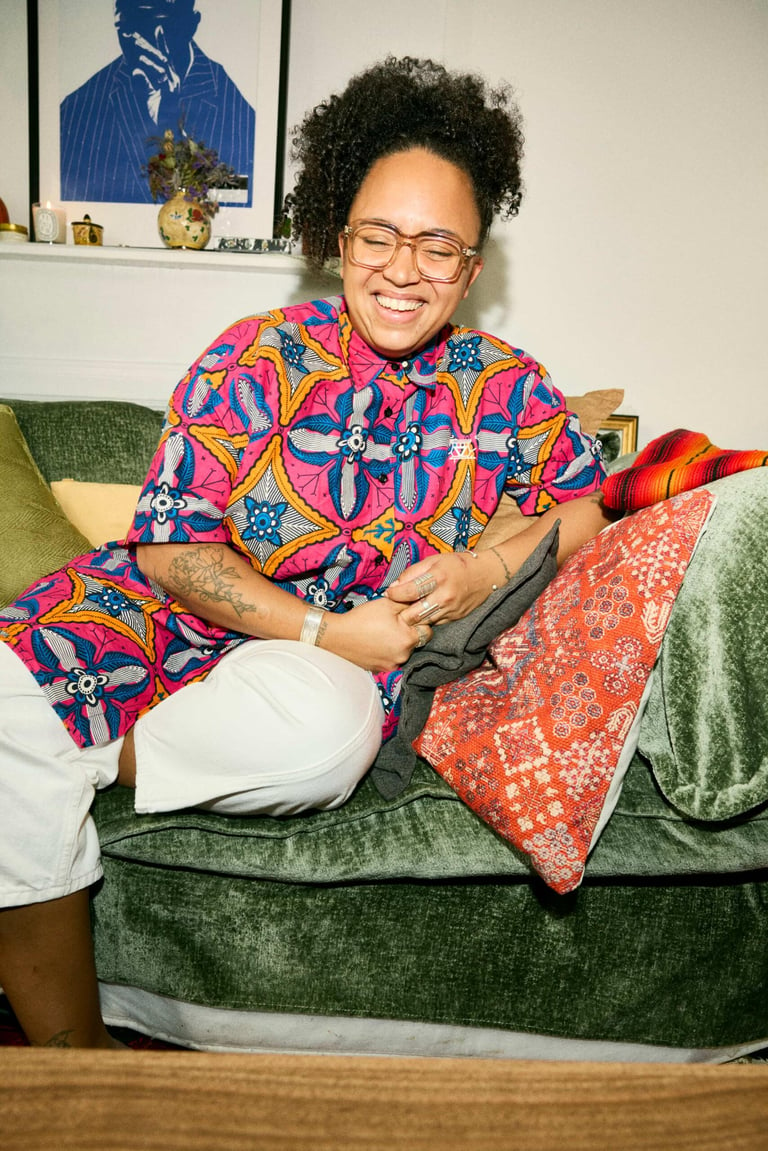
Having fun
Rediscovering the power
of playfulness
A key part of the journey towards more enjoyment is making hobbies, creativity and play essential elements of home life. Because playfulness isn’t just for kids.
When adults open up to activities that spark a sense of childlike joy and wonder in themselves, they can enhance not only their environment, but also the way they see it, interact with it, and act within it.
Top driver
People with a hobby have more fun.
Spending time on hobbies and interests (34%) ranks #2 globally in bringing enjoyment at home.
Top barrier
People have a tough time in busy homes.
People in larger households are less likely to enjoy spending time on their hobbies (7-person households 27% vs single-person 37%).
Relevant needs
Enjoyment
Security
Nurturing
Aspirations
Belonging
“Playfulness is an innate part of being human. However, like a muscle, it requires regular practice to stay strong. More than just a behaviour or an action, it’s also a mindset. And in today’s fast-paced and intense world, for many adults, it’s evolving into a transformative way of choosing to experience life.”
– Emma Worrollo, Playfulness Consultant
Main themes
2.1 Hobbies make us happy

Engaging in hobbies and interests can be an instant joy booster at home – with lasting effects that extend well beyond just making home a more enjoyable place to live. It can also impact our overall wellbeing in a positive way and shape the way we see life.
Key insight
Invested in our hobbies
People who get a sense of pride from working on their hobbies at home are more positive about their future (52% vs 48% global average).
“My Covid hobby was learning to crochet, which I like to do in the rainy Seattle months … I can start to feel guilty if I start to watch too much TV, so this activity allows me to feel good about making something but in a way that’s also relaxing and fun.”
– Seattle female, 30s
2.2 Playfulness needs enabling
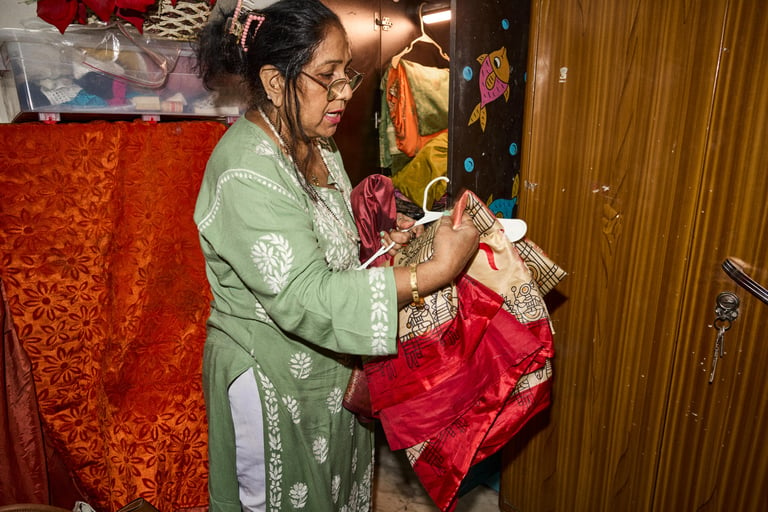
Most of us just don’t see fun as fundamental to our lives at home. But the factors standing in the way of playfulness also have the potential to enable it.
Key insight
No fun at home?
Only 14% of people globally say their homes bring out their playful side. But of those who do get a sense of playfulness at home, 61% feel positive about the future (vs 48% global average).
Key insight
It’s who you live with
Living with a sibling or children makes you more likely to experience play at home: +5% points with a sibling (vs those without), and +3% points with children (vs those without).
2.3 Fun is an antidote to stress
For most adults, everyday stress is a fact of life. But play can actually be a way to escape from pressure and stress, and increase happiness and wellbeing.
67%
of those who enjoy cooking in a slow, leisurely way*
68%
of those who enjoy experimenting in the kitchen*
72%
of those who involve kids in cooking*
*…are happy with their life at home. Compared to 61% global average.
Fun with food also makes us happy
Embracing the joys of cooking is a recipe for above-average scores for happiness in the home.
“I used to dislike cooking, but now I enjoy experimenting with recipes while listening to music or a podcast. I turn to my sister, who advises me on what to make.”
– Madrid female, 20s

What´s trending
Adult-friendly fun
Kidulting
A rising trend of adults engaging in light-hearted activities traditionally designed for children. From bubbles and balls to scribbling and doodling.
Product hacks
An independent movement where people are personalising IKEA products in simple but creative ways, turning them into bespoke items with a unique look.
“We all have different play preferences. You might like to explore, create, move, imagine or compete. You need to find your way. If you’re in contact with your way of playing, close to your own preference, I think the barrier is smaller.”
– Maria Törn, Range Area Manager, Children’s IKEA
3.

Building vibes
Personalising our spaces to reflect our true selves
Our homes should reflect who we are. Even without owning the space, we can dial up the joy through small personal touches that make it feel ‘ours’.
Whether through bold decor, sensory details or meaningful objects, we can shape our homes to better express our unique selves – and help us enjoy them that little bit more.
Top driver
Home improvement is (often) fun.
Improving the home I live in (22%) ranks #10 globally in bringing enjoyment at home.
Top barrier
Non-homeowners enjoy their home less.
Only 47% of people in rented accommodation often experience enjoyment at home, vs 56% of house owners and 54% of apartment owners.
Relevant needs
Enjoyment
Belonging
Aspirations
Nurturing
Comfort
“People are now realising that bold interiors are the way forward, with colour helping our spaces to better reflect our personalities. We’re thinking less about how we’re going to sell our homes in the future, and more about living and enjoying the moment.”
– Bhavin Taylor, Interior Designer
Main themes
3.1 Embracing uniqueness builds belonging
Feeling a sense of belonging where we live is part and parcel of enjoying our home. And leaning into what makes us unique helps us feel like we belong. What really makes a difference are the small things we do that make home feel like our true space.
Key insight
A home that reflects me
Of those who feel more belonging at home if they can express their identity there, 57% often experience enjoyment. Compared to 51% global average.
“Making your space feel ‘yours’ doesn’t have to be a static process. By transforming what you already have, finding new ways to use the same things, your vibes can change as you change. Like switching a cushion cover for the season or turning it into a piece of art.”
– Joana Afonso, Interior Design Specialist, IKEA Retail
3.2 For renters, the small changes matter
People who don’t own their home tend to have limited control over their spaces. However, they’re more likely to take a multisensory approach to feeling themselves at home.
College / University hall of residence
Renting a room
Co-living facility
Flat share
House – owned
House – rented
Apartment – owned
Apartment – rented
Living in parental home
Least joy for flat sharers
Those who live in a flat share (living in the same apartment as one or more other people and sharing the cost) are most likely to have difficulty experiencing enjoyment at home.

What´s trending
Vibe enablers
Dopamine decor
Outfitting homes with colours, textures, patterns and layering in playful elements. The goal? To create a personal, vibrant and happy space that sparks joy.
Biophilic design
Integrating natural materials (such as stone and wood) and elements (like plants and natural light) into the home to create a calming, restorative environment.
Smart home technology
Putting vibe setting at our fingertips, smart home products allow us to control various aspects of the home at the touch of a button.
4.
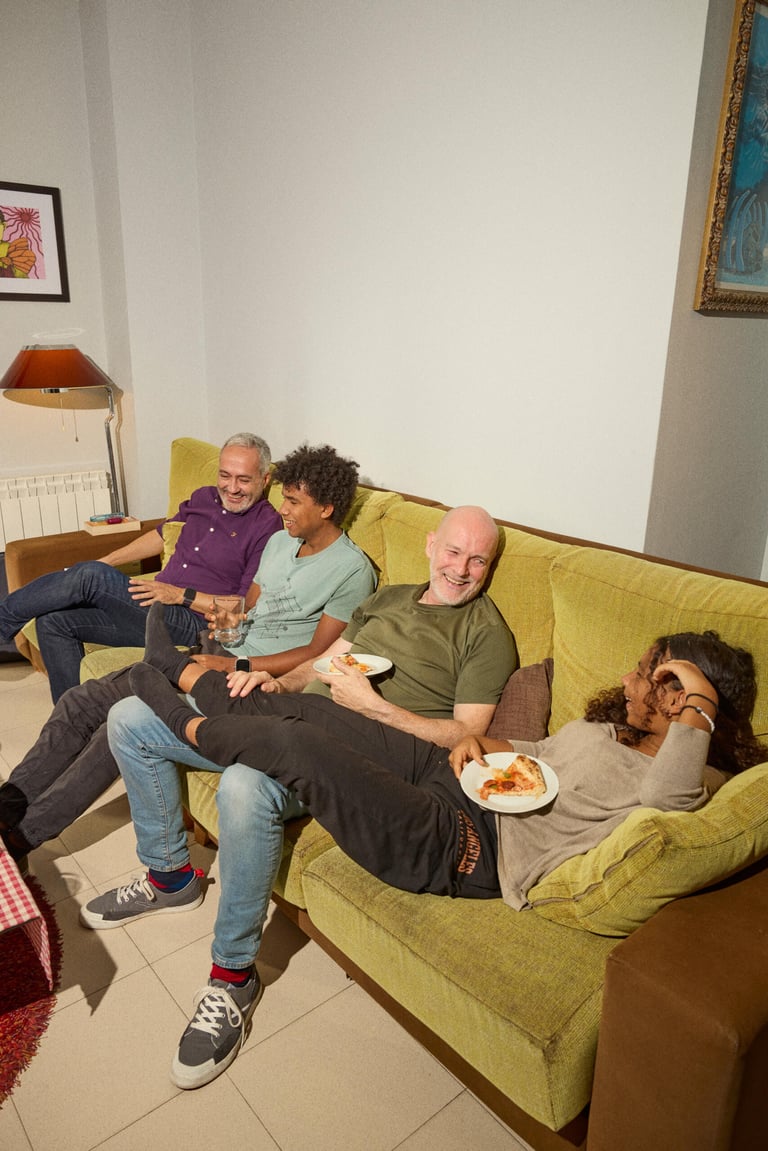
Making
connections
Finding ways to spend time with our tribes
Let us never estimate the power of togetherness and connection – with ourselves and others, in person or virtually.
Simple rituals like shared meals, conversations, me-time, community engagement, or just a good laugh now and then, can help us to nurture those connections and make home life more fulfilling and enjoyable.
Top driver
Hugs and laughs go a long, long way.
Hugs with a loved one (35%) and laughing with people around me (34%) rank #1 and #3 respectively in bringing enjoyment at home.
Top barrier
Small and big households are less together.
People in households with 1 person or 6+ people are less likely to say they enjoy togetherness in the home (1 person and 6+ people 21%, vs 2-5 people 24%).
Relevant needs
Enjoyment
Belonging
Comfort
Security
“We need to come together and gather in a way that’s special, unique and helps people not only be seen, heard and valued, but to see, hear and value you as well, and there’s nothing more intimate than inviting someone into your home.”
– Kim Dabbs, Expert in Belonging and Purpose
Main themes
4.1 Happiness starts at home
Who we live with can have a big influence on our happiness and outlook on life. And maintaining everyday rituals can be essential for connection – whether we live with others or on our own.
Key insight
Those who eat together, stick together
People who see eating as a social activity are +7% points more likely than average to experience belonging and enjoyment often at home.
Living and laughing…
Laughter is the best medicine
It’s not a myth! 68% of people who laugh with those around them are happy with life at home (vs 61% global average). And, as you can see from this breakdown by living situation, those living with children or grandchildren are among those who enjoy it the most.
4.2 Connection comes in different forms
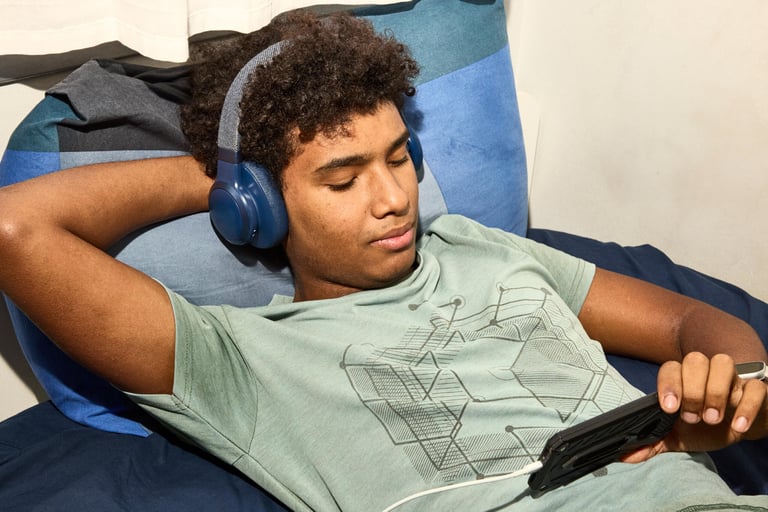
We don’t have to live with people to enjoy life at home. We can relish alone time and our own space, while also using technology and other means to connect with others and deepen relationships.
Key insight
Gaming to connect
People who game as a hobby are more likely to find belonging important at home (73% vs 70% global average), and to experience it often or sometimes (82% vs 81%).
Key insight
The joy of single living
Single-person households most enjoy spending time by themselves. 44% vs 33% global average.
4.3 Community counts

As we look to balance our online and offline lives, the idea of ‘household’ extends beyond the home – with community connections offering safety, visibility, company, and a sense of belonging.
Key insight
Helping helps
59% of people who help their community experience enjoyment at home often. Compared to 51% global average.
“When I first came to New York, I saw a guy walking in heels wearing nothing but a Speedo, and everyone was cheering him on saying ‘slay!’. Then I knew I wanted to move here.”
– New York City male, 40s
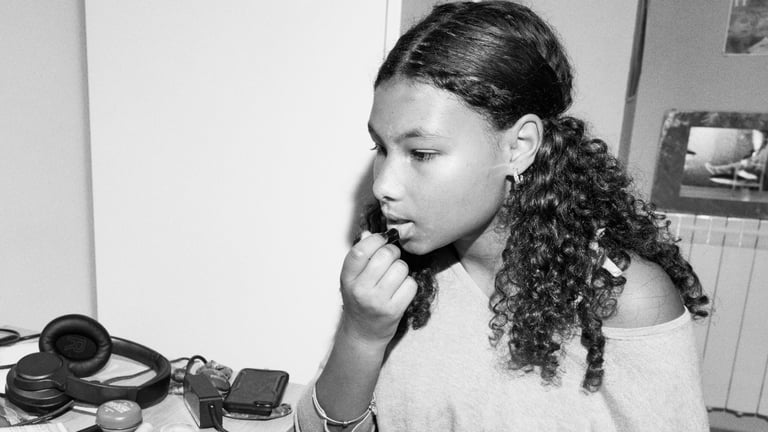
What´s trending
New ways to connect
Big Talk
Skipping the small talk and making space for deep conversations. From conversation cards at the kitchen table to intimate questions for couples to ask in the bedroom.
GRWM (get ready with me)
A popular social media trend where young (or young-at-heart) people come together online to put on make-up or get dressed up.
“While many parts of our lives are increasingly digital, it’s important to remember that we don’t, and can’t, only exist in either an online or physical bubble – we need both. Above all, we still find personal connections irreplaceable.”
– Matt Drage, Communications & Marketing Manager, Ingka Centres
What’s next?
Putting the recipe into practice
In stressful times, a touch of joy can go a long way. Understanding what does and doesn’t bring us joy in our living spaces can do wonders for our overall health and happiness.
Rethinking life at home in a few small but meaningful ways allows us not only to make space for more joy, but also to build the spirit and resilience we need to handle life’s tougher moments. And feel more optimistic about what’s to come.
At the heart of it, it’s about making simple, achievable, intentional choices that allow us to feel better not only at home, but also in life. Turning insights into actions.
Download this year’s complete report for a deeper exploration of enjoyment at home, not only today but also further forward – into a possible future where empathy and technology could both play a leading role in bringing joy home.
Featured homes
For this year’s life at home stories, we focused on six special homes in three different parts of the world. Allow us to introduce them.
David and Natalia
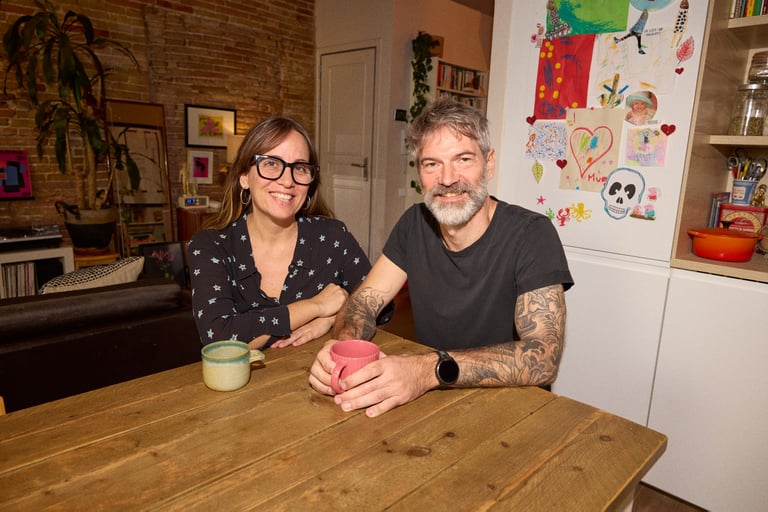
David and Natalia live centrally in Barcelona, Spain. They share their renovated 3-bed apartment with their two young children, their pet dog, a host of reused furniture, and more than a few musical instruments.
Estelle
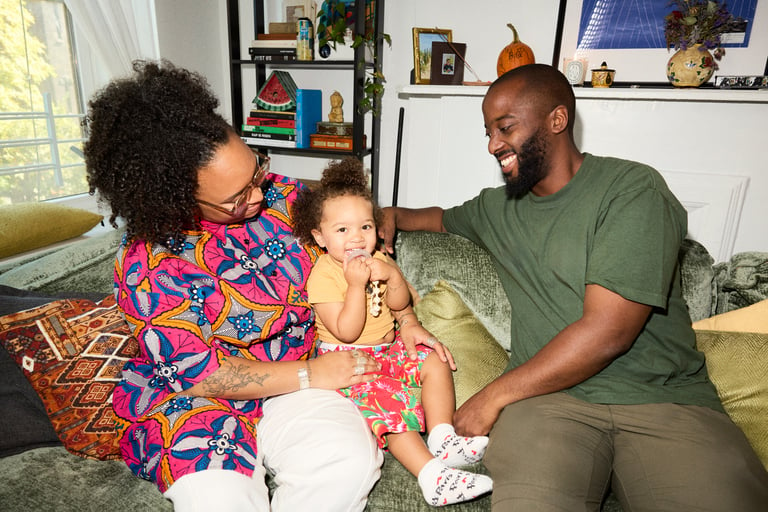
Estelle and her family rent a 2-bed apartment in Brooklyn, New York City, USA. A bartender turned entrepreneur, she enjoys a cosily creative and chaotic life with her husband and their two-year-old daughter.
Miquel and Daragh
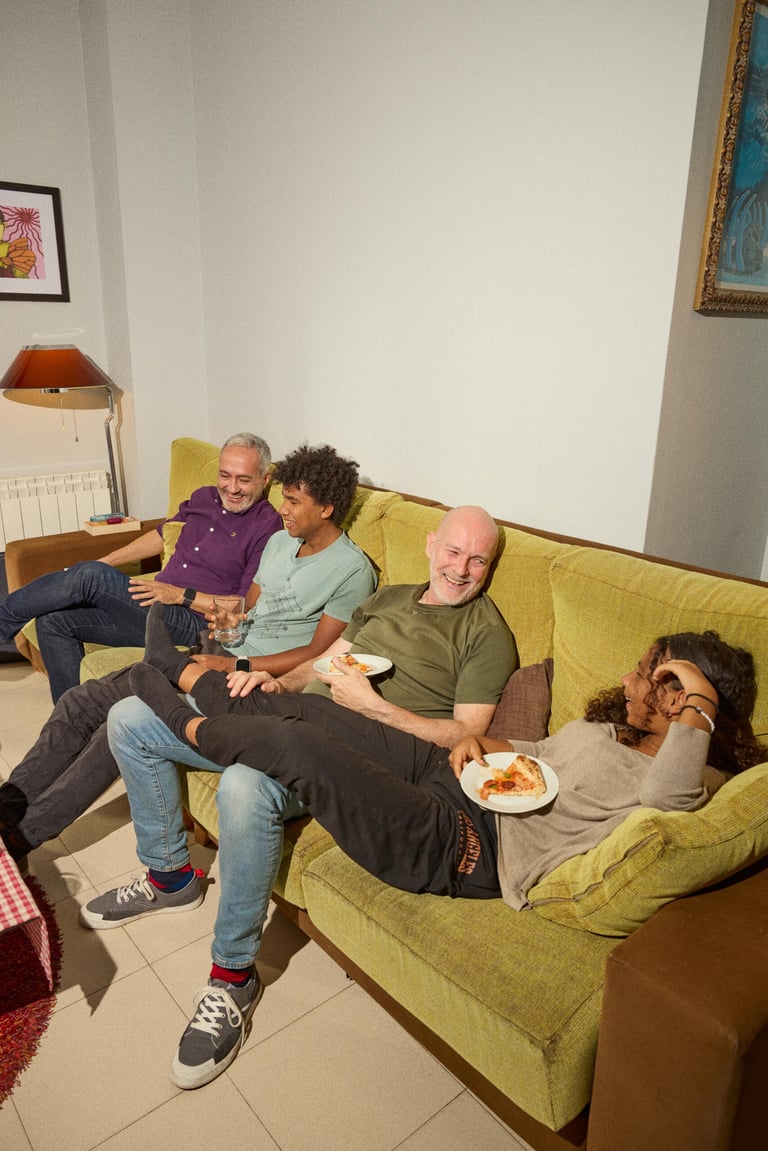
Miquel and Daragh also live in Barcelona, in a rented apartment on the east side of town. With two teenage children and a shared passion for music and dance, there’s never a dull moment in their busy household.
Nikhil
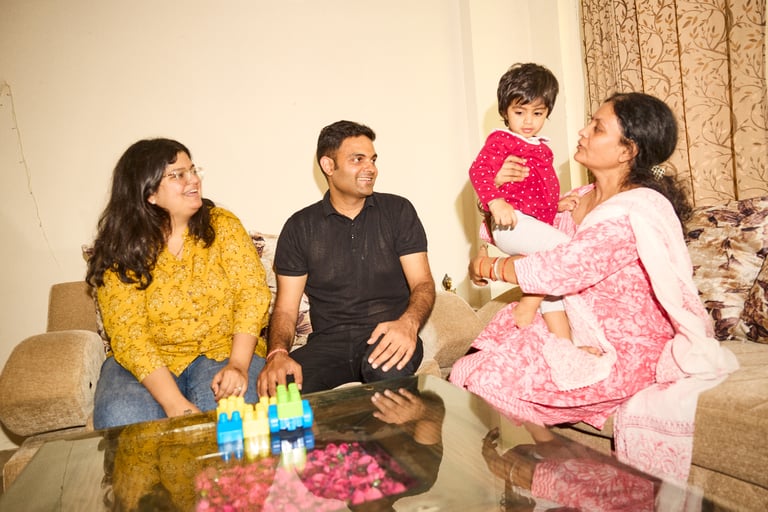
Nikhil and his family own a multigenerational home in Gurugram, a suburb of Delhi, India. Living harmoniously under the same roof as Nikhil are his wife, daughter, parents, brother, and sister-in-law.
Rita
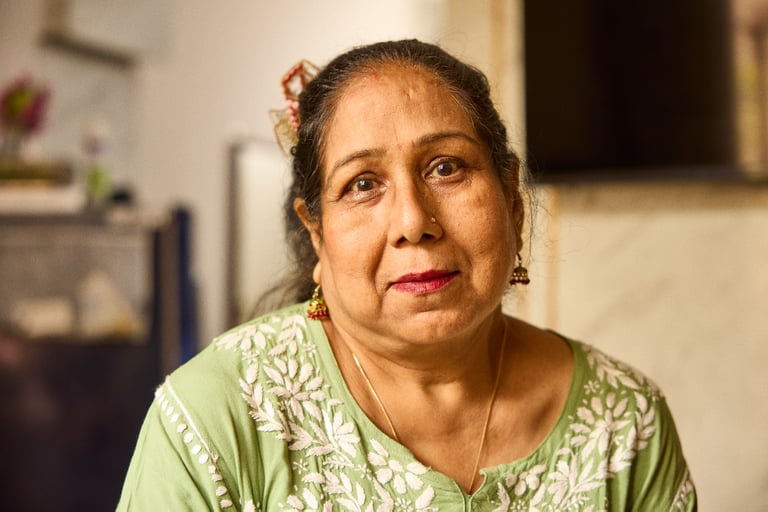
Rita owns a 2-bed apartment in South Delhi. A teacher and social media enthusiast, her life at home revolves around her husband, the local community, and her ever-evolving interior design solutions.
Yajun
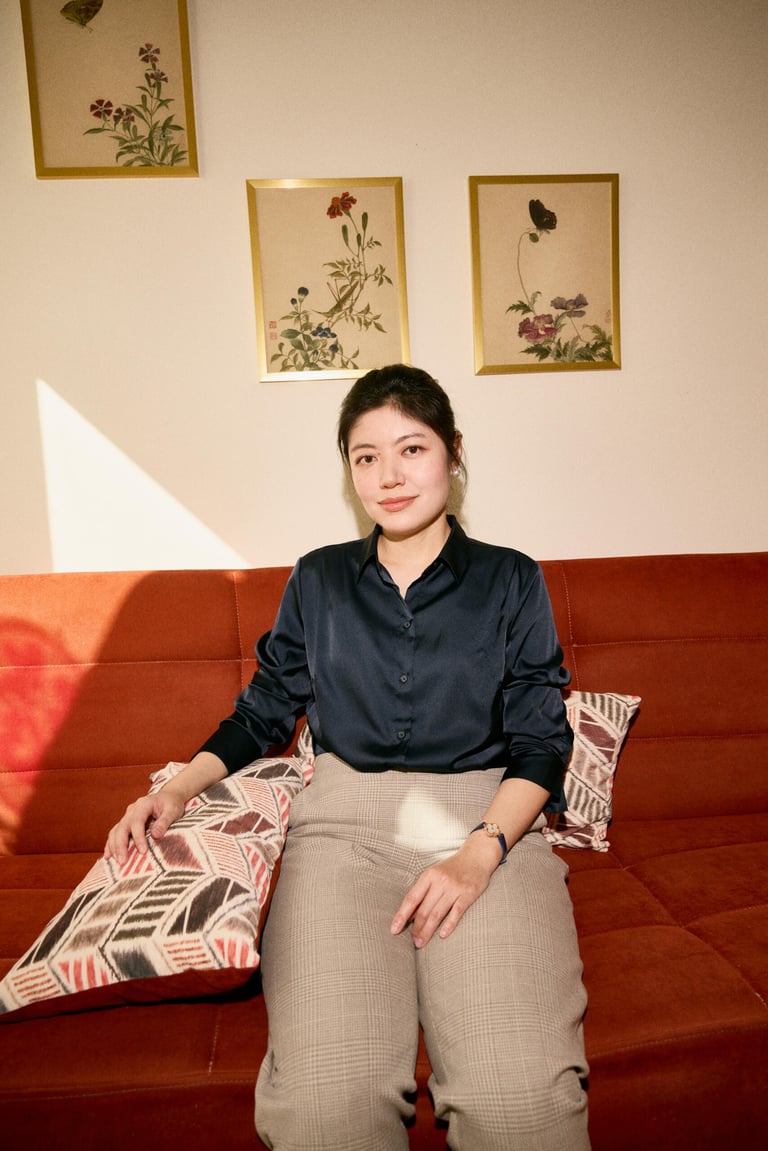
Yajun lives alone in a studio apartment in Manhattan, New York City, on the 5th floor of an apartment block that towers 50+ storeys into the sky. Her home is her sanctuary in the heart of the bustling city.
